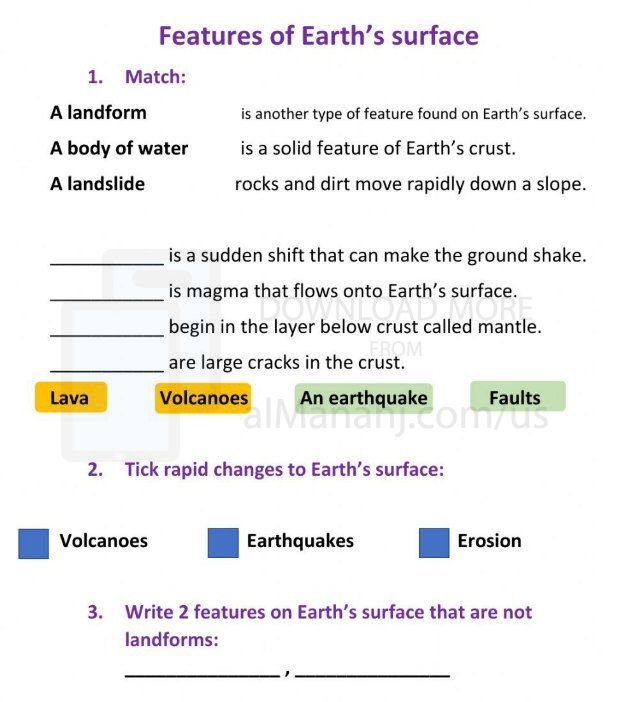| You are here: Almanahj Website ⇒ American curriculum ⇒ 6th Grade ⇒ Geology ⇒ Term 1 | ||
|---|---|---|
Worksheet about Features on Earth's surface | ||
|---|---|---|
| Subject: Geology | ||
| 6th Grade | ||
| Term 1 | ||
| Year: 2023/2024 | ||
| Size: 260.7KB | ||
| Number of clicks: 152 | ||
| Publish date:November 27, 2023 | ||
| Added by: Eman | ||
| Last download date: 2024-09-11 08:53:23 | By: theodor Una_sun | |
| File info: The Earth's surface is diverse and characterized by various features that have been shaped by geological processes, weathering, erosion, and other natural phenomena. Here are some notable features on the Earth's surface: 1. Mountains: Mountains are large landforms that rise significantly above the surrounding terrain. They are typically characterized by steep slopes, rugged topography, and high elevations. Mountains are often formed through tectonic processes such as plate collisions or volcanic activity. Examples include the Himalayas, the Andes, and the Rocky Mountains. 2. Plateaus: Plateaus are elevated flat or gently rolling areas of land that are bounded by steep slopes or cliffs. They are usually located at higher elevations and can be formed through various geological processes such as volcanic activity, tectonic uplift, or erosion. Plateaus can be extensive, covering large regions and often exhibit unique ecosystems. The Colorado Plateau in the United States and the Deccan Plateau in India are examples of significant plateaus. 3. Plains: Plains are vast, relatively flat areas with low relief. They are typically formed through the deposition of sediment over long periods of time by rivers, wind, or glaciers. Plains are widespread and can be found on every continent. They often provide fertile soil for agriculture and are heavily populated. Examples of notable plains include the Great Plains in North America and the Indo-Gangetic Plain in South Asia. 4. Valleys: Valleys are low-lying areas between mountains or hills, often carved by rivers or glaciers. They are characterized by their U-shaped or V-shaped cross-sectional profiles. Valleys can be narrow or wide, and they may contain rivers, lakes, or agricultural land. Examples of famous valleys include the Grand Canyon in the United States and the Nile Valley in Africa. 5. Deserts: Deserts are arid regions characterized by low precipitation and sparse vegetation. They can be sandy, rocky, or a combination of both. Deserts may be formed due to geographical factors such as rain shadow effects, proximity to cold ocean currents, or the presence of large mountain ranges. Prominent deserts include the Sahara Desert in Africa, the Mojave Desert in North America, and the Gobi Desert in Asia. 6. Oceans and Seas: Oceans and seas are large bodies of saltwater that cover about 71% of the Earth's surface. They play a crucial role in regulating climate, supporting marine life, and influencing weather patterns. The major oceans include the Pacific Ocean, the Atlantic Ocean, the Indian Ocean, and the Southern Ocean. Seas are smaller bodies of saltwater partially enclosed by land. 7. Rivers and Lakes: Rivers are flowing bodies of water that typically originate from mountains or highlands and flow towards the sea or other bodies of water. They play a vital role in shaping the landscape, carrying sediments, and providing freshwater for ecosystems and human use. Lakes, on the other hand, are inland bodies of water that are often formed through geological processes such as tectonic activity or glacial activity. These are just a few examples of the diverse features found on the Earth's surface. The planet's surface is a dynamic and ever-changing mosaic of landforms, water bodies, and ecosystems, shaped by a complex interplay of geological, climatic, and biological processes. | ||
| Downloading link Worksheet about Features on Earth's surface |
|---|
|
1701065084.pdf
The file is being prepared for download
|
| File images |
|---|
 |